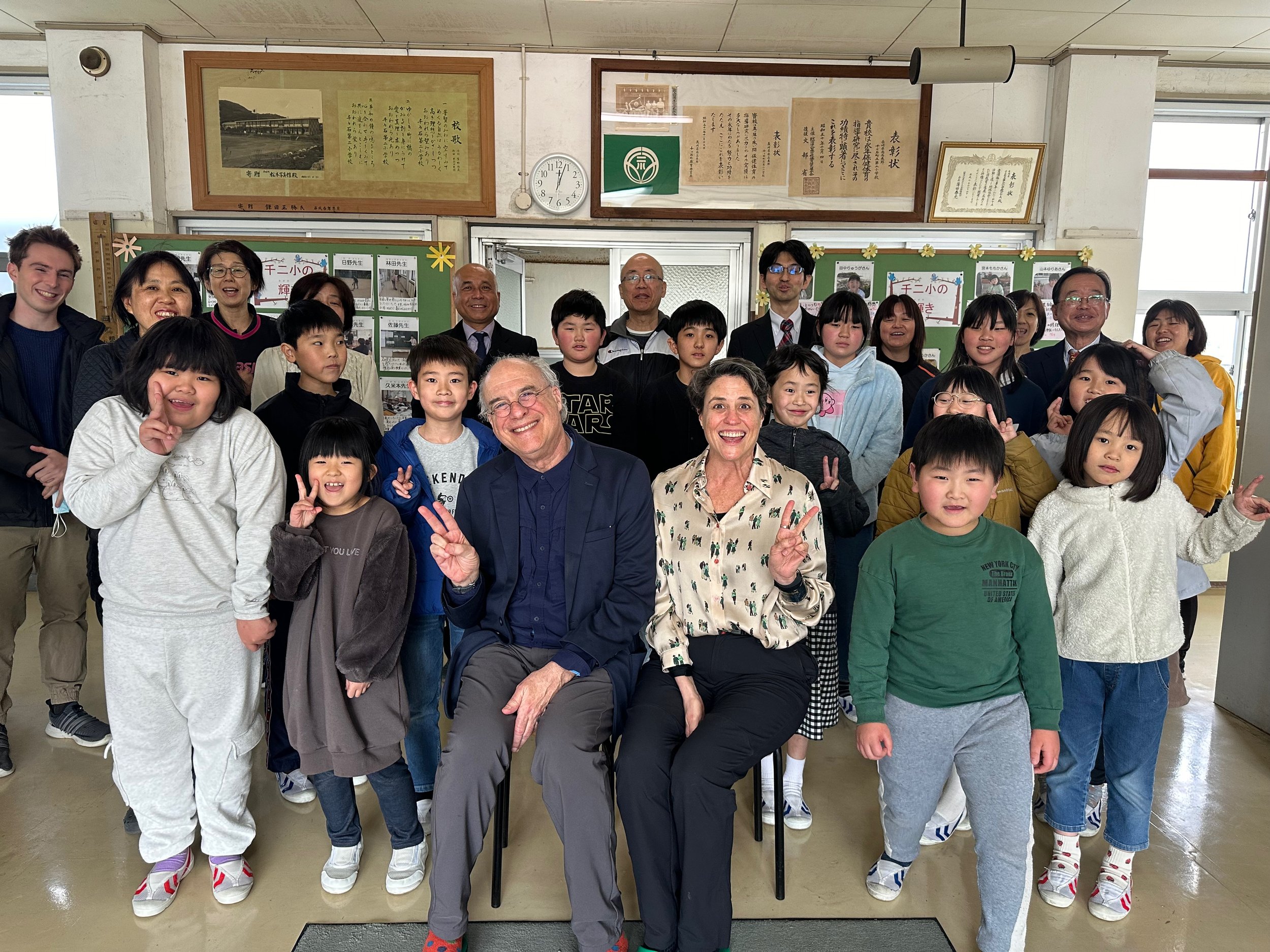School Lunch, Japanese style
A first grader serving lunch to her classmates
Upon arrival in Japan (Nagasaki), we were driven to a rural area northeast of the city on the island of Kyushu, to “Chijiwa School Lunch Center,” a commercial kitchen where hot lunch is prepared for 11 schools (7 elementary schools and 4 junior high schools), serving 1750 students. There are centers throughout Japan that operate similarly. The whole system is extraordinary and US schools would be well advised to take notice. Here’s how it works:
A worker at the Lunch Center making a vat of dashi
The facility (paid for by local and national governments) receives fish, meat, fruit, vegetables (i.e. real food) from a number of producers – striving to source regionally. Once delivered to the kitchen, 18 cooks prepare lunch each school day from scratch. The menus are written by an employee (a nutritionist) well ahead of time and with input from the ‘menu committee’ made up of students, teachers and parents. The kitchen is extremely efficient with different stations preparing different parts of the meal, each wearing a distinguishing colorful apron. For the day we visited, the menu consisted of “scattered sushi (rice mixed with vegetable and tofu), canola flower soup that was dashi based and had chicken, flowering greens, grilled amberjack with miso, and asparagus dressed with roasted sesame oil. This was served with a carton of milk and a small bag of rice crackers, the only processed food on the tray. The center publishes the daily menu, listing all of the ingredients and makes it available to the families (see photo).
Today’s school lunch menu with every ingredient
When each menu item is finished, the cooks transfer them to quite beautiful, gleaming stainless steel covered containers that are then loaded into uniform wheeled stainless steel boxes that can maintain temperature. These boxes are rolled onto 10 trucks, each headed to one or more of the schools.
We asked about the economics of the whole operation. The annual budget for the meal ingredients is 260JY, or $2, per meal. The families pay for their students to cover these costs – if a family can’t afford it, there is support from the local city government. The wages of the workers (about 30 in this School Center, including the cooks, delivery people and admin) is covered by the City, where most educational costs lie. So, basically, the local government pays for the system and the families pay for the food ingredients.
Once delivered to the schools, a rotating team of students from 1st grade on, with a little help from their teachers, set up the containers in the lunch room. Again, extremely organized with special wheeled carts that make moving the containers into the room easy. They form a buffet line and the students on lunch duty that day stand behind each dish ready to serve. Once that is all set up, students and everyone who works at the school and any special guests, like us, grab a tray and start down the line. Once provisioned, they return to their desk – in this case, assembled in a circle, and patiently wait until everyone has received their food.
Students serving up lunch
Our school was unusually small – just 13 students in all grades – which made it very communal. There was a student tasked with announcing the menu of the day and saying a few words and then we ate.
With the delightful students and staff at Chijiwa Daini Elementary School
Needless to say, it was the best school lunch I’ve ever experienced – really, quite a fabulous lunch period. Simple, tasty – totally healthy. And I loved that the teachers and school administrators were all eating the same, communal meal together.
Our lunch
The students are required to finish everything before getting up to rinse off their plates and sort them for returning back to the School Lunch Center for cleaning and being used for the next meal.
A few things deserve special mention: First, the amount of time allotted for lunch. Easily 45 mins, maybe even an hour. Plenty of time to eat, chat and hear announcements. The students practiced their English on us – with lots of giggles and their very favorite slogan “nice to meet you” oft repeated. Second, on the board of the lunch room there is a rotating display of what local vegetables and fish are in season and a very specific map detailing where they come from. Third, after all the plates are cleared away, the students retrieve their toothbrushes and a cup of water, someone puts on the tooth brushing song and everyone (including the teachers) brushes their teeth altogether for at least two minutes.
We left amidst a gaggle of happy, healthy kids with full bellies and inspired minds. Of course there are some efforts that are trying hard to reform the US school food lunch programs (Food Corps and Edible Schoolyard of particular note), but it seems like such a no-brainer to create a similar national lunch system that would no doubt have dramatic health and social outcomes. And, perhaps most importantly, be delicious.








